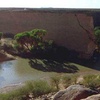Disclaimer
This entry contains information known to us from a variety of sources but may not include all the information currently available. Please be in touch if you notice any inadvertent mistakes in our presentation or have additional knowledge or sources to share. Thank you.
Archive
The "Mountain of the Jews" at Khaybar, Saudi Arabia
Just off the main road heading north—about 95 miles outside of Medina—are the remains of Khaybar, a striking oasis that is home to the "Masada of Arabia." At the summit of what is still known as the "Mountain of the Jews" is the Jewish fortress of Qamos. Essentially forgotten by Jews today, this ancient center of Jewish life is remembered throughout the Muslim world, and particularly by Shia, as the scene of a pivotal battle in early Islamic history.
Description
Khaybar was divided into three districts—Nataah, Shaq, and Katibah—each of which contained several villages and citadels, often perched on the high ground overlooking the extensive date palm groves, corn fields, and other crops below1. The region's volcanic soil and moderate climate made it well-suited for agriculture2. In addition to cultivation, the residents were accomplished traders, metal workers, and silk garment producers. These highly prized skills enabled Khaybar to thrive and amass great wealth, especially in comparison to the other communities of the Hijaz.
حصون اليهود في خيبر2
However, these assets proved to be a liability in the tumultuous political environment of 7th century Arabia. According to traditional Islamic sources, in 628, the Prophet Muhammad concluded a peace agreement with Mecca's Quraysh tribe at Hudaibiyah, thus giving him a freehand to consolidate power before the inevitable final assault on Mecca. With Medina's security assured by the treaty, the Prophet turned his attention to a prior dispute dating to 625 with the Banu Nadir, a Jewish tribe he had expelled from Medina. They had subsequently sought refuge with their northern co-religionists3.
Sixteen-hundred soldiers and one to two hundred cavalry marched on Khaybar under the Prophet's colors. Due to their rapid and strategic approach—Khaybar was cut off from its allies—the inhabitants were unprepared for the attack. While several villages and fortifications fell fairly quickly after being besieged, these defeats bought enough time for a proper defense to be mounted at those places the Jews still held. At Katibah, for example, some of the Jewish defenders arrayed themselves in the open before the Prophet's army, the imposing citadel of Qamos at their backs.
The hubris of Khaybar's leaders, who had thought their fortifications were impregnable, and Ali's battlefield heroics contributed to a decisive defeat for the Jewish resistance. Qamos surrendered, as did the last hold-outs not long thereafter. The terms of surrender allowed the Jews the option to flee without their property, or to stay and retain at least their land, provided that half of its yearly yield was paid in taxes. The latter became known in Shari'a law as jizyah, the special tax (though, usually at a lower rate) thereafter required of all non-Muslims in Islamic countries. The immediate aftermath of the conquest saw the uncovering of hidden treasurers, and, following her husband's murder, the beautiful Jewess Safiya was taken by the Prophet as a wife.
Jews continued to live in Khaybar even after formal expulsion in 642, but it never regained its former splendor. Khaybar's refugees are said to have settled primarily in Kufa (in Iraq), Jericho, and in the case of the Muhamara clan, Tiberias.4 The ruins of Khaybar are preserved as an antiquities site by the Kingdom of Saudi Arabia. While barbwire prevents access to the heights, the cemetery and other low-lying areas are accessible.
Sources
[1] Al Mubarakpuri, Safi ur Rahman. When the Moon Split, (Riyadh: Darussalam, 1998), 231. http://books.google.com/books?id=xJL6gxPUV4EC&pg=PA236
[2] Zwemer, Samuel, Marinus. Arabia: the Cradle of Islam, (Edinburgh and London: Oliphant Anderson and Ferrier, 1900), 23. http://books.google.com/books?id=bh4YAAAAYAAJ&pg=PA251
[3] Haykal, Muhammad, Husayn. The Life of Muhammad, (Selangor: Islamic Book Trust, 2008), 380-383. http://books.google.com/books?id=fOyO-TSo5nEC&pg=PA380
[4] Zeitlin, Irving M. The Historical Muhammad, (Malden: Polity, 2007), 130-131. http://books.google.com/books?id=v_seJ21M0UoC
![Qamos Fortress [3] (Khaybar, Saudia Arabia, 2008)](https://cdn.filestackcontent.com/vllEWv8SrWnvi1owU84A/convert?w=100&h=100&fit=crop)
![Qamos Fortress [2] (Khaybar, Saudia Arabia, 2008)](https://cdn.filestackcontent.com/4trJMuQiQAK1ePLCppNd/convert?w=100&h=100&fit=crop)
![Qamos Fortress [1] (Khaybar, Saudia Arabia, 2008)](https://cdn.filestackcontent.com/L9eBHD7USBCGd70r0g9y/convert?w=100&h=100&fit=crop)






![Qamos Fortress, Aerial View [2] (Khaybar, Saudia Arabia, 2008)](https://cdn.filestackcontent.com/FMtbG5pASzef6UrWaSge/convert?w=100&h=100&fit=crop)
![Qamos Fortress, Aerial View [1] (Khaybar, Saudia Arabia, 2008)](https://cdn.filestackcontent.com/fXOqfUeQvaC63rUPTqpb/convert?w=100&h=100&fit=crop)





